Despite all the abundance of courses to help you learn Data Science from scratch , do not forget about the benefits of books. With their help, you can learn not only the basics, but also deepen your knowledge in this vast, for that we are writing about the Best Data Science Books.
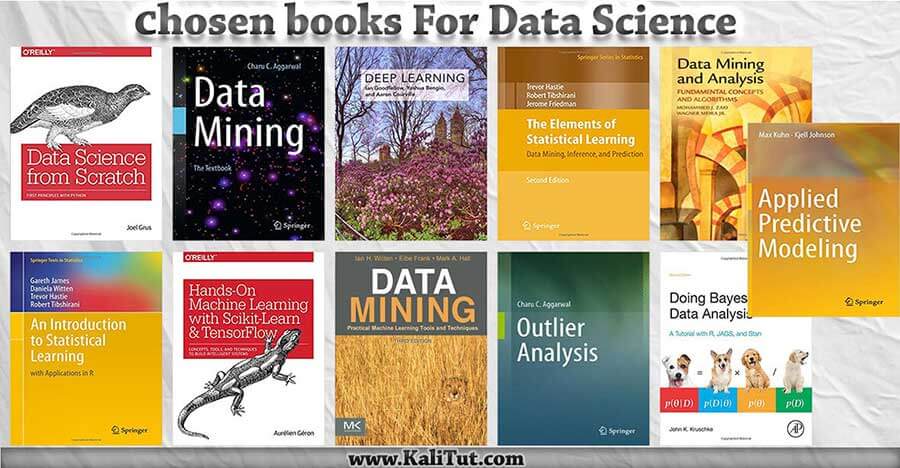
Data Science is a data science that combines programming, machine learning, mathematics, and a number of other disciplines. Science is quite complex and requires versatile development, as well as continuous improvement of its knowledge and skills.
Choosing a data science book is one of the important steps to properly learn from experts in the field. It doesn’t have to be labeled as a data science book as it can relate to one of its many branches.
As the field of Data Science continues to heat up fast, there are an increasing number of options to gain an education in this area.
Today we will highlight the best Data Science books to learn from.
What is Data Science?
There is much debate among scholars and practitioners about what data science is, and what it isn’t. Does it deal only with big data? What constitutes big data? Is data science really that new? How is it different from statistics and analytics?
One way to consider data science is as an evolutionary step in interdisciplinary fields like business analysis that incorporates computer science, modeling, statistics, analytics, and mathematics.
At its core, data science involves using automated methods to analyze massive amounts of data and to extract knowledge from them. With such automated methods turning up everywhere from genomics to high-energy physics, data science is helping to create new branches of science, and influencing areas of social science and the humanities. The trend is expected to accelerate in the coming years as data from mobile sensors, sophisticated instruments, the web, and more, grows. In academic research, we will see an increasingly large number of traditional disciplines spawning new sub-disciplines with the adjective “computational” or “quantitative” in front of them. In industry, we will see data science transforming everything from healthcare to media.
A novice specialist must be able to write code in Python and analyze their work.
We have compiled for you the Best Data Science Books that every Data Scientist and anyone who wants to become one should read it.
How to choose the best data science books
Choosing a suitable data science book is very important. An unsuitable book will waste your time and energy.
Sometimes, the outline of the book may be exactly what you want. But as you read in depth, you may find that the author only touched the surface, not enough. This situation also happened to me before. I wrote this article to let you avoid this situation.
When we choose books related to data science, we should check the following points:
See the author’s personal profile: it can help to understand the author’s background, his research and main interests, but also shows some details of this book. But also give new authors a chance not to make this a key.
Read the preamble carefully: most books can read its preface for free online. Please read this section carefully. In most cases, in this part, the author will not only introduce the writing background, but also explain the details of each chapter.
Choose a book with independent chapters: This is my personal preference, comparing a technical book is not a novel. Although it is important to learn from the book from easy to difficult, step by step, but choosing a book with more or less independent chapters will give you a structural grasp of the book.
Read online reviews: First of all, do n’t believe all reviews. After all, reviews are subjective, but online reviews can understand people ’s general views on this book. We often say: Do n’t judge the quality of a book by its cover. Amazon ’s comments are worthy of reference, and people will make insightful comments and criticisms of the author.
Best Data Science Books
Data Science from Scratch: First Principles with Python
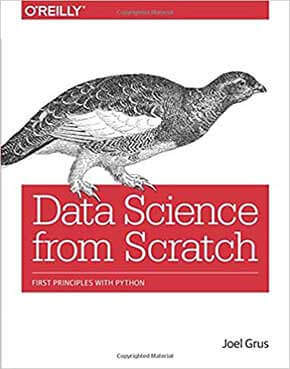
Data science libraries, frameworks, modules, and toolkits are great for doing data science, but they’re also a good way to dive into the discipline without actually understanding data science. In this book, you’ll learn how many of the most fundamental data science tools and algorithms work by implementing them from scratch.
If you have an aptitude for mathematics and some programming skills, author Joel Grus will help you get comfortable with the math and statistics at the core of data science, and with hacking skills you need to get started as a data scientist. Today’s messy glut of data holds answers to questions no one’s even thought to ask. This book provides you with the know-how to dig those answers out.
- Get a crash course in Python
- Learn the basics of linear algebra, statistics, and probability—and understand how and when they’re used in data science
- Collect, explore, clean, munge, and manipulate data
- Dive into the fundamentals of machine learning
- Implement models such as k-nearest Neighbors, Naive Bayes, linear and logistic regression, decision trees, neural networks, and clustering
- Explore recommender systems, natural language processing, network analysis, MapReduce, and databases
Data mining textbook
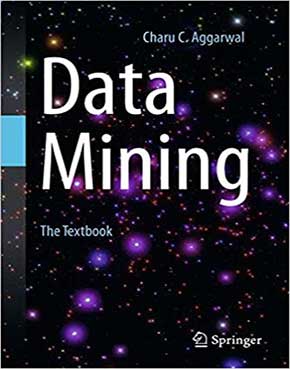
This textbook explores the different aspects of data mining from the fundamentals to the complex data types and their applications, capturing the wide diversity of problem domains for data mining issues. It goes beyond the traditional focus on data mining problems to introduce advanced data types such as text, time series, discrete sequences, spatial data, graph data, and social networks. Until now, no single book has addressed all these topics in a comprehensive and integrated way. The chapters of this book fall into one of three categories:
- Fundamental chapters: Data mining has four main problems, which correspond to clustering, classification, association pattern mining, and outlier analysis. These chapters comprehensively discuss a wide variety of methods for these problems.
- Domain chapters: These chapters discuss the specific methods used for different domains of data such as text data, time-series data, sequence data, graph data, and spatial data.
- Application chapters: These chapters study important applications such as stream mining, Web mining, ranking, recommendations, social networks, and privacy preservation. The domain chapters also have an applied flavor.
Appropriate for both introductory and advanced data mining courses, Data Mining: The Textbook balances mathematical details and intuition. It contains the necessary mathematical details for professors and researchers, but it is presented in a simple and intuitive style to improve accessibility for students and industrial practitioners (including those with a limited mathematical background). Numerous illustrations, examples, and exercises are included, with an emphasis on semantically interpretable examples.
Deep Learning (Adaptive Computation and Machine Learning series)
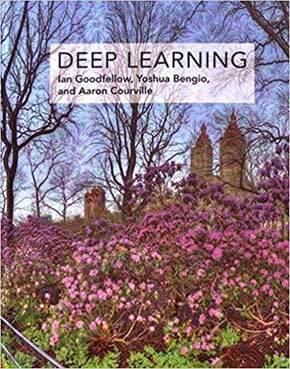
Deep Learning (Adaptive Computation and Machine Learning series) introduces a broad range of topics in deep learning.
The text offers mathematical and conceptual background, covering relevant concepts in linear algebra, probability theory and information theory, numerical computation, and machine learning. It describes deep learning techniques used by practitioners in industry, including deep feedforward networks, regularization, optimization algorithms, convolutional networks, sequence modeling, and practical methodology; and it surveys such applications as natural language processing, speech recognition, computer vision, online recommendation systems, bioinformatics, and videogames. Finally, the book offers research perspectives, covering such theoretical topics as linear factor models, autoencoders, representation learning, structured probabilistic models, Monte Carlo methods, the partition function, approximate inference, and deep generative models.
Hardcover: 800 pages
The content of the book includes 3 parts:
- Part 1 introduces basic mathematical tools and machine learning concepts, which are the preliminary knowledge of deep learning;
- Part 2 systematically and in-depth explains the mature deep learning methods and technologies today;
- Part 3 Discuss certain forward-looking directions and ideas, which are recognized as the future research focus of deep learning.
“Deep Learning” is suitable for all kinds of readers, including college students or graduate students of related majors, and do not have a machine learning or statistical background, but want to quickly supplement deep learning knowledge for application in actual products or platforms
The elements of statistical learning: data mining, inference, and prediction
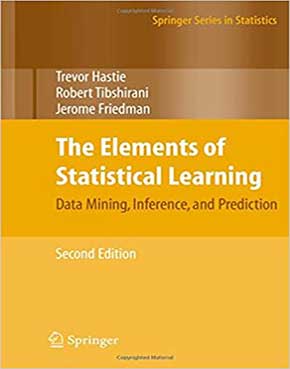
During the past decade there has been an explosion in computation and information technology. With it have come vast amounts of data in a variety of fields such as medicine, biology, finance, and marketing. The challenge of understanding these data has led to the development of new tools in the field of statistics, and spawned new areas such as data mining, machine learning, and bioinformatics. Many of these tools have common underpinnings but are often expressed with different terminology. This book describes the important ideas in these areas in a common conceptual framework. While the approach is statistical, the emphasis is on concepts rather than mathematics. Many examples are given, with a liberal use of color graphics. It is a valuable resource for statisticians and anyone interested in data mining in science or industry.
This book describes the important ideas in a variety of fields such as medicine, biology, finance, and marketing in a common conceptual framework. While the approach is statistical, the emphasis is on concepts rather than mathematics. Many examples are given, with a liberal use of colour graphics. It is a valuable resource for statisticians and anyone interested in data mining in science or industry. The book’s coverage is broad, from supervised learning (prediction) to unsupervised learning. The many topics include neural networks, support vector machines, classification trees and boosting—the first comprehensive treatment of this topic in any book.
Hardcover: 745 pages
Data Mining and Analysis: Fundamental Concepts and Algorithms
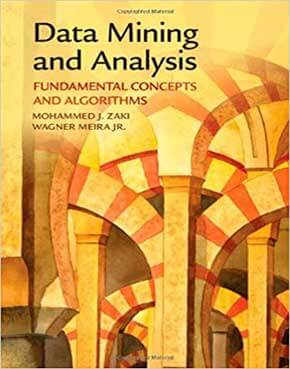
This is one of the best books on data science, The fundamental algorithms in data mining and analysis form the basis for the emerging field of data science, which includes automated methods to analyze patterns and models for all kinds of data, with applications ranging from scientific discovery to business intelligence and analytics. This textbook for senior undergraduate and graduate data mining courses provides a broad yet in-depth overview of data mining, integrating related concepts from machine learning and statistics. The main parts of the book include exploratory data analysis, pattern mining, clustering, and classification. The book lays the basic foundations of these tasks, and also covers cutting-edge topics such as kernel methods, high-dimensional data analysis, and complex graphs and networks. With its comprehensive coverage, algorithmic perspective, and wealth of examples, this book offers solid guidance in data mining for students, researchers, and practitioners alike.
Hardcover: 562 pages
Key features
- Covers both core methods and cutting-edge research
- Algorithmic approach with open-source implementations
- Minimal prerequisites: all key mathematical concepts are presented, as is the intuition behind the formulas
- Short, self-contained chapters with class-tested examples and exercises allow for flexibility in designing a course and for easy reference
- Supplementary website with lecture slides, videos, project ideas, and more
an introduction to statistical learning with applications in r
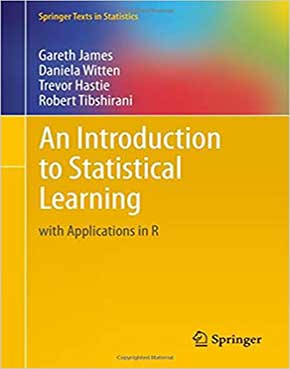
An Introduction to Statistical Learning provides an accessible overview of the field of statistical learning, an essential toolset for making sense of the vast and complex data sets that have emerged in fields ranging from biology to finance to marketing to astrophysics in the past twenty years. This book presents some of the most important modeling and prediction techniques, along with relevant applications. Topics include linear regression, classification, resampling methods, shrinkage approaches, tree-based methods, support vector machines, clustering, and more. Color graphics and real-world examples are used to illustrate the methods presented. Since the goal of this textbook is to facilitate the use of these statistical learning techniques by practitioners in science, industry, and other fields, each chapter contains a tutorial on implementing the analyses and methods presented in R, an extremely popular open source statistical software platform.
Hardcover: 426 pages
hands on machine learning with scikit-learn and tensorflow
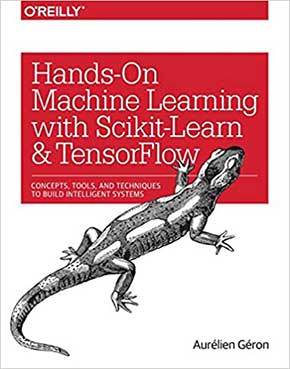
Concepts, Tools, and Techniques to Build Intelligent Systems
through a series of recent breakthroughs, deep learning has boosted the entire field of machine learning. Now, even programmers who know close to nothing about this technology can use simple, efficient tools to implement programs capable of learning from data. This practical book shows you how.
By using concrete examples, minimal theory, and two production-ready Python frameworks—scikit-learn and TensorFlow—author Aurélien Géron helps you gain an intuitive understanding of the concepts and tools for building intelligent systems.
You’ll learn a range of techniques, starting with simple linear regression and progressing to deep neural networks. With exercises in each chapter to help you apply what you’ve learned, all you need is programming experience to get started.
- Explore the machine learning landscape, particularly neural nets
- Use scikit-learn to track an example machine-learning project end-to-end
- Explore several training models, including support vector machines, decision trees, random forests, and ensemble methods
- Use the TensorFlow library to build and train neural nets
- Dive into neural net architectures, including convolutional nets, recurrent nets, and deep reinforcement learning
- Learn techniques for training and scaling deep neural nets
- Apply practical code examples without acquiring excessive machine learning theory or algorithm details
Applied Predictive Modeling
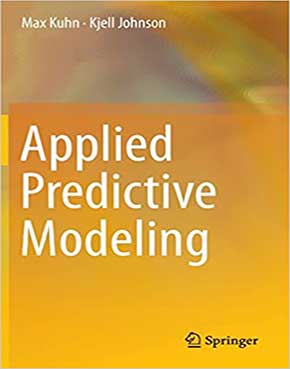
Applied Predictive Modeling covers the overall predictive modeling process, beginning with the crucial steps of data preprocessing, data splitting and foundations of model tuning. The text then provides intuitive explanations of numerous common and modern regression and classification techniques, always with an emphasis on illustrating and solving real data problems. Addressing practical concerns extends beyond model fitting to topics such as handling class imbalance, selecting predictors, and pinpointing causes of poor model performance―all of which are problems that occur frequently in practice.
The text illustrates all parts of the modeling process through many hands-on, real-life examples. And every chapter contains extensive R code for each step of the process. The data sets and corresponding code are available in the book’s companion Applied Predictive Modeling R package, which is freely available on the CRAN archive.
Data Mining: Practical Machine Learning Tools and Techniques

Data Mining: Practical Machine Learning Tools and Techniques, Third Edition, is one of the Best Data Science Books, it offers a thorough grounding in machine learning concepts as well as practical advice on applying machine learning tools and techniques in real-world data mining situations. This highly anticipated third edition of the most acclaimed work on data mining and machine learning will teach you everything you need to know about preparing inputs, interpreting outputs, evaluating results, and the algorithmic methods at the heart of successful data mining.
The book is targeted at information systems practitioners, programmers, consultants, developers, information technology managers, specification writers, data analysts, data modelers, database R&D professionals, data warehouse engineers, data mining professionals. The book will also be useful for professors and students of upper-level undergraduate and graduate-level data mining and machine learning courses who want to incorporate data mining as part of their data management knowledge base and expertise.
- Provides a thorough grounding in machine learning concepts as well as practical advice on applying the tools and techniques to your data mining projects
- Offers concrete tips and techniques for performance improvement that work by transforming the input or output in machine learning methods
- Includes downloadable Weka software toolkit, a collection of machine learning algorithms for data mining tasks-in an updated, interactive interface. Algorithms in toolkit cover: data pre-processing, classification, regression, clustering, association rules, visualization
Outlier Analysis
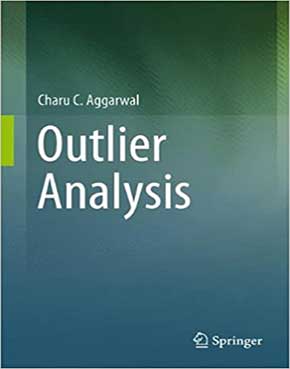
With the increasing advances in hardware technology for data collection, and advances in software technology (databases) for data organization, computer scientists have increasingly participated in the latest advancements of the outlier analysis field. Computer scientists, specifically, approach this field based on their practical experiences in managing large amounts of data, and with far fewer assumptions– the data can be of any type, structured or unstructured, and may be extremely large. Outlier Analysis is a comprehensive exposition, as understood by data mining experts, statisticians and computer scientists.
The book has been organized carefully, and emphasis was placed on simplifying the content, so that students and practitioners can also benefit. Chapters will typically cover one of three areas: methods and techniques commonly used in outlier analysis, such as linear methods, proximity-based methods, subspace methods, and supervised methods; data domains, such as, text, categorical, mixed-attribute, time-series, streaming, discrete sequence, spatial and network data; and key applications of these methods as applied to diverse domains such as credit card fraud detection, intrusion detection, medical diagnosis, earth science, web log analytics, and social network analysis are covered.
doing bayesian data analysis: a tutorial with r, jags, and stan
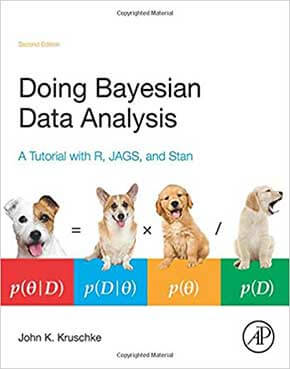
Doing Bayesian Data Analysis: A Tutorial with R, JAGS, and Stan, Second Edition provides an accessible approach for conducting Bayesian data analysis, as material is explained clearly with concrete examples. Included are step-by-step instructions on how to carry out Bayesian data analyses in the popular and free software R and WinBugs, as well as new programs in JAGS and Stan. The new programs are designed to be much easier to use than the scripts in the first edition. In particular, there are now compact high-level scripts that make it easy to run the programs on your own data sets.
This book is intended for first-year graduate students or advanced undergraduates in statistics, data analysis, psychology, cognitive science, social sciences, clinical sciences, and consumer sciences in business.
- Accessible, including the basics of essential concepts of probability and random sampling
- Examples with R programming language and JAGS software
- Comprehensive coverage of all scenarios addressed by non-Bayesian textbooks: t-tests, analysis of variance (ANOVA) and comparisons in ANOVA, multiple regression, and chi-square (contingency table analysis)
- Coverage of experiment planning
- R and JAGS computer programming code on website
- Exercises have explicit purposes and guidelines for accomplishment
- Provides step-by-step instructions on how to conduct Bayesian data analyses in the popular and free software R and WinBugs
our list of The Best Data Science Books has come to an end… but what about you ? what’s the Best Data Science Books you read ? and what books do you plan to get ?

Leave a Reply